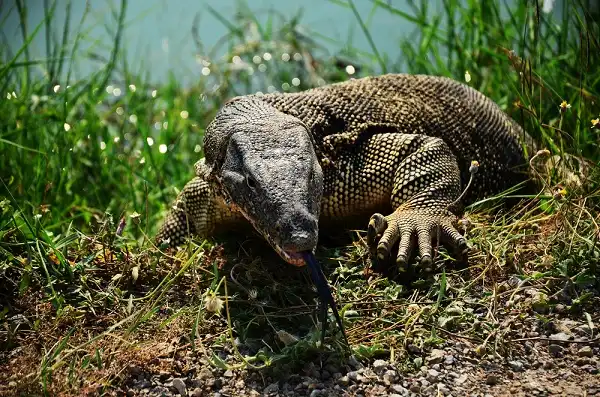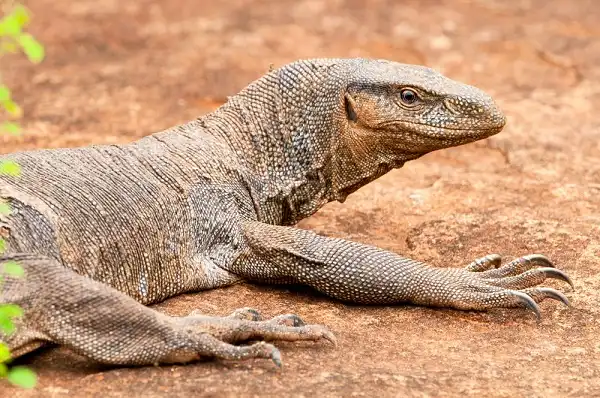Are you ready to learn all about one of the most interesting and unique animals in the world? Monitor lizards get their name from their behavior of seeming to “monitor” or keep an eye on their environment. With dozens of species found around the globe, these reptiles can come in a variety of shapes and sizes from small desert-dwelling goannas to giant water monitors living near rivers and swamps. Read on for more fascinating details about monitor lizards!

Monitor Lizard Description
Monitor lizards are incredibly diverse animals, with many species varying greatly in size, shape, and color. The smallest of these creatures is the Gould’s monitor. On the other end of the spectrum is the Komodo dragon. Coloration also varies among species, from bright yellows and greens to dark blacks and browns. They have a wide range of body shapes as well. These lizards may be slender and streamlined for running or aquatic life like goannas or thick and bulky for digging like the savanna monitors. Most species have powerful tails that help them balance when climbing trees, while others like the African rock python have flattened tales that act as rudder-like paddles when swimming in water.
Monitor Lizard Habitat
Monitor lizards live in a variety of habitats around the world, from tropical and subtropical forests to deserts and swamps. Some species are even adapted to living in urban areas, such as the water monitor which is commonly seen in cities like Bangkok and Singapore. In their natural habitat, these reptiles prefer environments that provide plenty of food sources and places to hide. This could mean perching in trees or burrowing into mud holes for cover. Depending on the species, they may also be found near streams and lakes where they hunt for fish or amphibians.
Monitor Lizard Diet
Monitor lizards have an omnivorous diet, meaning they eat both plants and animals. Depending on the species and individual lizard, their diet can vary significantly in composition. Smaller species like the Gould’s monitor will feast on insects, small mammals, eggs, and frogs. Larger lizards like Komodo dragons are known to prey on deer, pigs, and even smaller lizards. In addition to these meaty meals, many monitor lizards also enjoy a variety of fruits and vegetables such as bananas or melons when available. They will also consume carrion or scavenge for dead animals if the opportunity arises. Monitor lizards may also feed on smaller reptiles such as snakes or other lizards that they come across in their environment.

Monitor Lizard Size
Monitor lizards come in a range of sizes, from the relatively small Gould’s monitor which grows to about 15 inches in length, to the massive Komodo dragon which can reach up to 10 feet in length! The Savannah monitor is known for its bulky body structure and reaches lengths of up to 6 feet. Other species such as the African rock python also have flattened tails that help them swim through water more efficiently. Size is not always an accurate indication of species, however, since some of the smaller species are just as fierce predators as their larger counterparts. In terms of weight, monitor lizards can range anywhere from a few pounds to over 100 pounds; the heaviest on record is a Komodo dragon weighing an astonishing 154 pounds!
Monitor Lizard Lifespan
Monitor lizards have long lifespans, with some species living up to 20 years in the wild! Captive monitor lizards can potentially live even longer, with some reaching up to 40 years or more. However, this can vary greatly depending on various factors such as species, size, diet, and environment. In general, larger species tend to have longer lifespans than smaller ones. This is due to their slower growth rate and ability to store more fat reserves which help them survive in harsher environments or periods of food scarcity. Additionally, captive monitor lizards that are provided with a consistent diet and proper care typically live much longer than those in the wild since they are not exposed to predators or harsh climates.
Monitor Lizard Behavior
Monitor lizards have a wide range of behaviors that are seen in different species and even between individuals. These behaviors can include anything from burrowing, sunning on rocks, swimming in water, or even tree-climbing for certain species. In general, monitor lizards are solitary animals though some species may live in small groups or form pairs during the breeding season. In terms of communication, monitor lizards use a variety of vocalizations to express themselves. They can hiss, grunt, snort, and make clicking noises depending on their moods and the situation they find themselves in. Some species also possess dewlap glands which they use to secrete pheromones to attract potential mates or mark their territories. Monitor lizards are highly territorial and will defend their area fiercely by charging at intruders with open mouths and using their sharp teeth and claws to ward them off. They may also raise their heads and spread out their frills to make themselves appear larger in order to intimidate potential threats.

Monitor Lizard Speed
Monitor lizards are surprisingly fast creatures, especially considering their cold-blooded nature. Certain species can reach speeds of up to 24 mph when sprinting, making them some of the fastest land animals in the world! They achieve this speed by alternating between running on all four legs and using their powerful tails to propel themselves forward. The Savannah monitor is known for its impressive bursts of speed; it can run up to 10 miles per hour over short distances! Other species such as the Komodo dragon also use their long tails as a rudder and can even swim at speeds of 2-3 mph. This ability allows them to chase after prey in water or cross large bodies of water with ease. In addition to sheer speed, monitor lizards are also incredibly adept climbers. Some species such as the Papua New Guinea prehensile-tailed skink can climb trees at speeds up to 9 mph! Their claws and sharp teeth make it easy for them to hang onto branches while they search for food or escape from predators.
Monitor Lizard Species
There are around 70 known species of monitor lizards that can be found across the world, ranging from Africa to Australia and even some parts of Asia. These lizards vary greatly in terms of size, coloration, and behavior depending on their environment and particular species. The largest monitor lizard is the Komodo dragon which can reach lengths up to 10 feet and weigh up to 200 pounds! This impressive reptile has a distinct look with its yellowish skin, long forked tongue and sharp claws and teeth that help it catch prey. It resides mainly on the Indonesian island of Komodo where it is now an endangered species due to habitat loss.
Other well-known monitor lizards include the Nile monitor, which is one of the most widespread species due to its ability to adapt quickly to new environments; as well as the black tree monitor which is native to New Guinea, Indonesia, and other nearby islands. The black tree monitor has a distinctive triangular head, blue body, and yellow stripes along its sides that make it easily recognizable in the wild. More aquatic species such as crocodile monitors are also quite common; they typically inhabit slow-moving rivers or swamps in Southeast Asia and have webbed feet that aid them in swimming. Additionally, there are several smaller species of monitors such as earless monitors which can reach a maximum length of 14 inches; they prefer living in tropical forests or grasslands where they feed mainly on small insects.
Monitor Lizard Reproduction
Monitor lizards reproduce through a process known as oviparity, which involves the production of eggs that are then laid and left to incubate. Depending on the species, female monitor lizards may lay between 5-20 eggs per clutch with an average of 8-10 eggs. The eggs are typically white or cream-colored and measure anywhere from 1-3 inches in length. During the incubation period, female lizards will often guard their nests and make sure they remain safe from potential predators. Once they have hatched, baby monitor lizards are independent and must fend for themselves almost immediately; they can reach full adult size within 2-4 years depending on their species. Mating for monitor lizards usually occurs during the spring months when temperatures start to rise after a cold winter season. To attract potential mates, male lizards will often perform courtship rituals where they display vibrant colors and make loud vocalizations such as hissing or grunting sounds.

Monitor Lizard Hunting
Monitor lizards are incredibly efficient predators that rely on their speed and agility to hunt successfully. Some species such as Komodo dragons use their long, forked tongues to taste the air for potential prey while others such as Nile monitors are able to detect the slightest vibrations in the ground. Regardless of their hunting style, these lizards employ a wide array of tactics to track down and capture their food. Most species prefer to hunt during the day or at night when temperatures are cooler, and they often ambush their prey or wait patiently in one area until an opportunity arises. When pursuing prey, monitor lizards using their powerful legs to sprint after them at speeds up to 10 miles per hour! They also use their long tails as a rudder, helping them make sharp turns while chasing after prey.
In addition to using speed and agility when hunting, monitor lizards can also rely on other senses such as smell or sight depending on the type of prey they are pursuing. For example, some species may be able to detect small rodents by sensing pheromones in the air while others may see small birds from a distance and then pursue them with lightning-quick reflexes. Once they catch up with their target, monitor lizards will usually grasp it firmly with their claws before delivering a lethal bite with their strong jaws filled with sharp teeth; this allows them to kill most animals instantly before consuming them whole. They also have powerful digestive systems capable of breaking down large chunks of food so that they can extract all the nutrients needed for growth and survival.
Conclusion
Monitor lizards are incredibly diverse creatures that inhabit a variety of habitats around the world. From Nile monitors living in hot deserts to Komodo dragons inhabiting tropical islands; these reptiles show remarkable adaptability and have become successful hunters through the millennia! Not only do monitor lizards possess impressive physical attributes such as powerful legs, sharp claws, and keen senses; but they also demonstrate unique reproductive behaviors and hunting strategies that allow them to survive even in extreme conditions. All in all, these fascinating reptiles are an integral part of many ecosystems throughout the world and should be appreciated for their exceptional roles as predators! With careful conservation efforts, we can ensure that monitor lizards will continue to thrive for generations to come!
Frequently Asked Question

